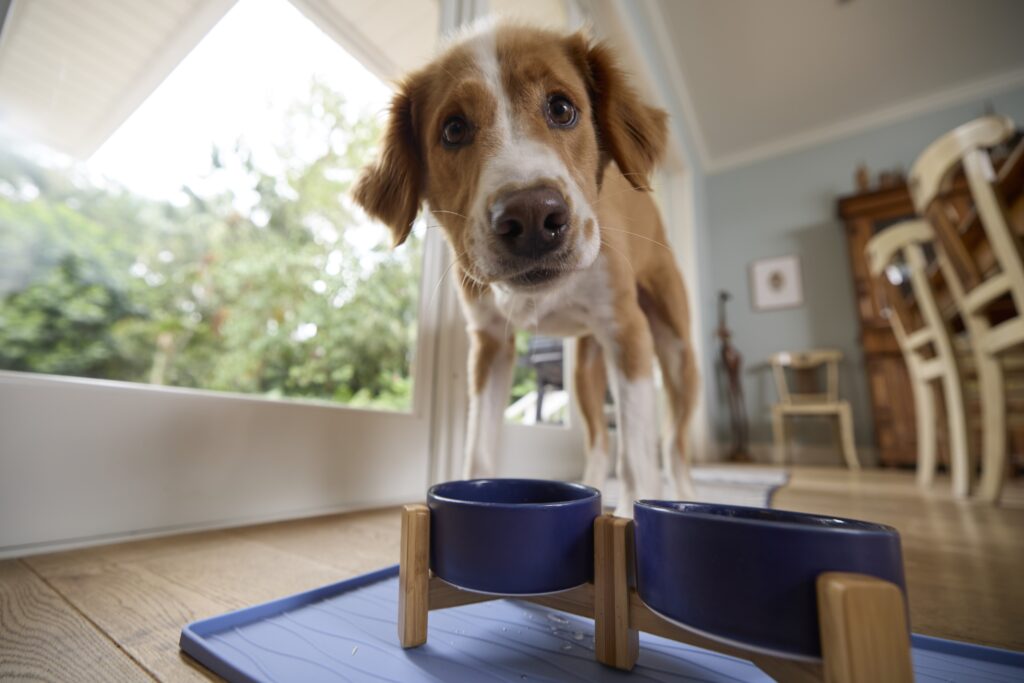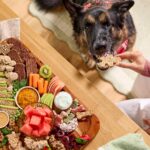Air-Dried Dog Food: Is It Right for Your Pup?

Photo by Chewy
If you’re a pet parent who wants the best for your dog, you may be curious about air-dried dog food—a minimally processed, shelf-stable option that is somewhat similar to a raw diet.
But what exactly is air-dried dog food, and is it the right choice for your pup? Here’s what to know before adding air-dried food to your dog’s bowl.
Key Takeaways
- Air-dried dog food is slowly dehydrated to preserve nutrients and create a jerky-like texture.
- Choose formulas that are AAFCO-compliant with whole protein sources.
- Pros include better nutrient retention, high digestibility, and appeal for picky eaters.
- But there are cons too: It comes with health risks, it is calorie-dense and low in moisture, and it doesn’t suit all dietary needs.
What Is Air-Dried Dog Food?
Air-dried dog food is made by slowly drying raw ingredients—typically meat, organs, or fish, and sometimes small amounts of fruits and veggies.
The food is placed in a drying chamber where warm air circulates, gently drawing out moisture through evaporation. Vitamins, minerals, and other important nutrients are also added to the food.
This process takes much longer to produce than traditional kibble, but it helps preserve nutrients, says Chris Hummel, DVM, a veterinarian at Lovet Pet Health Care.
The result is a jerky-like product that may be soft and pliable, or firm and crunchy, depending on the brand. Air-dried food can be fed as a complete meal (if labeled “complete and balanced”), mixed with kibble or wet food, or used as a nutrient-dense topper or treat.
While it’s not exactly the same as raw dog food, air-dried dog food is similar in a key way—neither food undergoes high-heat cooking. This lack of cooking is responsible for some of the foods’ supposed benefits—however, cooking also provides important advantages like killing off pathogens that can make pets and people sick.
What Should You Look for in an Air-Dried Dog Food?
Before you buy an air-dried food, ask your vet if it’s a good fit for your dog.
“It’s important to remember that the superiority of any food depends less on the food type and more on formulation quality, ingredient sourcing, nutrient balance, and appropriateness for the individual dog based on life-stage, breed, and underlying conditions,” says Ann Marie Zollo, DVM, DACVECC, senior veterinarian and specialist in the Emergency & Critical Care department at the Schwarzman Animal Medical Center in New York City.
So, some dogs may do best on a more traditional diet, and many pet parents may not want to risk the health warnings that come with raw and dried foods.
But if your vet thinks air-dried food is a good fit, here’s what to look for:
AAFCO Compliance
As with any primary dog food, choose a formula with an Association of American Feed Control Officials (AAFCO) statement saying the nutrition is “complete and balanced” for your dog’s life stage.
If you’re just using it as a treat or topper that makes up less than 10% of your dog’s diet, the “complete and balanced” labeling isn’t necessary (since a treat or topper isn’t where your dog gets most of their nutrients).
High-Quality Proteins
Look for products that contain whole, named protein sources, such as chicken, beef, lamb, and salmon. Meat, organs, or fish should appear first on the ingredients list.
Pros of Air-Dried Dog Food
Air-dried dog food is not right for every dog. However, here are some possible benefits often linked to air-dried food.
Nutrient Protection
“Air-dried dog food is made by slowly removing moisture at low temperatures, which helps preserve more natural nutrients and enzymes, compared to kibble that is cooked under high heat during extrusion,” Dr. Hummel says.
Because it’s so nutrient-dense, a smaller portion of air-dried food can deliver the same nutrition as a larger serving of kibble.
Easier To Digest
Air-dried food may be easier on a dog’s digestive system than heavily processed kibble, since the air-drying process helps preserve natural enzymes that support healthy digestion, Dr. Hummel says.
It’s Good for Picky Eaters
Adding air-dried food as a topper can boost the taste of your dog’s regular meals, says Dr. Zollo.
This can be especially helpful for picky eaters, senior dogs with reduced appetites, or pups recovering from illness who need extra encouragement to eat and benefit from a nutrient-dense food.
No (or Fewer) Artificial Preservatives
Since the drying process helps to preserve the food, many air-dried formulas don’t include artificial preservatives, although some ingredients may still have been preserved in this manner.
Air-dried dog food is also easy to store, transport, portion, and serve—no refrigeration, thawing, or prep required.
Cons of Air-Dried Food
However, air-dried food is not the right fit for every dog. Here are some cons of air-dried formulas.
They Can Be a Health Risk
Jennifer Larsen, DVM, a professor of clinical nutrition at UC Davis School of Veterinary Medicine, warns that the process of air-drying doesn’t fully kill pathogens, which raises the risk of bacterial contamination compared with kibble, wet diets, and other fully cooked foods.
While the risk of foodborne illness may be lower than with raw diets, air-dried food is still a concern for the health of both pets and people. This is especially true for immunocompromised pets and people and in homes with young children orolder family members.
They’re Not a Fit for All Dogs
Always ask your vet if a food is right for your dog. For example, large-breed puppies require carefully balanced calcium and phosphorus levels for proper growth, and they may not get that in air-dried foods that are not specifically labeled for large breed puppies.
Conditions like kidney or liver disease, heart disease, or diabetes often call for specialized diets as well.
They’re Less Hydrating
The drying process removes most of the water content, which isn’t ideal for dogs who need more hydration. Wet or fresh dog foods may be a better option in these cases.
They’re Calorie Dense
Air-dried foods are calorie-dense and easy to overfeed, which may lead to obesity.
Best Air-Dried Dog Food
Here are some highly rated air-dried dog foods:
A highly rated air-dried dog food with superfoods: Badlands Ranch Superfood Complete Air-Dried Beef Dog Food
Recommended Product
A highly rated good-all-around air-dried dog food: The Pets Table Beef & Berries Grain-Free Air-Dried Dog Food
Recommended Product
A highly rated ethically sourced air-dried dog food: ZIWI Peak Beef Grain-Free Air-Dried Dog Food
Recommended Product
A highly rated high-protein air-dried dog food: Pawstruck Beef High Protein Grain-Free Air-Dried Dog Food
Recommended Product
A highly rated air-dried dog food topper: Solid Gold Complete & Balanced Beef Recipe Air-Dried Dog Food Topper
Recommended Product
FAQs About Air-Dried Dog Food
Which is better: freeze-dried or air-dried dog food?
It depends on your preferences. Freeze-dried food usually requires rehydration. Air-dried food is gently dried at low heat, making it ready to serve and easier to handle. Both options can pose a risk of foodborne illness due to bacterial contamination.
Can air-dried dog food be frozen?
Yes, you can freeze it to extend shelf life, but it isn’t necessary. Just store air-dried food in a cool, dry place in a sealed bag or container, but always check the label for specific storage recommendations.
Do you add water to air-dried dog food?
No, air-dried dog food is ready to serve as is. That said, some pet parents add a little warm water or broth to make it softer or more aromatic, especially for senior dogs or picky eaters.
Is air-dried dog food the same as dehydrated dog food?
No, water is removed from dehydrated food using relatively high heat, while air-dried food uses a gentler, low-temperature process involving air circulation to evaporate moisture from raw ingredients.
Do vets recommend air-dried dog foods?
Some veterinarians recommend air-dried foods, but not all do, primarily because of the risk of bacterial contamination and foodborne illness. Always consult your own vet before switching your dog’s food.








